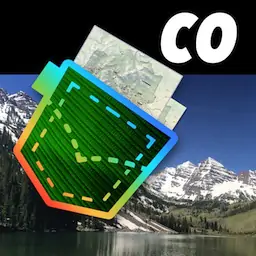by Alex Gugel , all rights reserved
Rock LayersColorado National Monument |
Brochure about the Rock Layers of the Monument for Colorado National Monument (NM) in Colorado. Published by the National Park Service (NPS).
featured in
| National Parks Pocket Maps |  | |
| Colorado Pocket Maps |  |
01294 Rock Layers.kb:01294 Rock Layers.kb
8/24/06
3:41 PM
Page 1
Colorado
National Monument
National Park Service U.S.
Department of the Interior
Colorado National Monument
Fruita, Colorado
ROCK LAYERS OF THE MONUMENT
The rocks of Colorado National Monument record a fascinating story of mountain building,
enormous amounts of erosion, and changing climates, as the continent of North America
gradually moved northward toward its present position.
PRECAMBRIAN
TRIASSIC
JURASSIC
The dark-colored rock at the bottom of the
canyons is Precambrian in age, dated at
1.7 billion years old. These rocks were
originally sedimentary rocks, but were
changed into metamorphic rocks and partly
melted into igneous rocks when the area that
is now Colorado collided with ancient
North America and became part of the
continent. There is a huge gap in the
geologic record at the contact of these rocks
with the overlying red sedimentary rocks.
The record of about 1.5 billion years of
earth’s history is missing! We know from
surrounding areas that this region was
uplifted into a major mountain range which,
after hundreds of millions of years, was
finally eroded low enough that sediments
could be deposited where the mountains
once stood.
The lowest and oldest layer of sedimentary
rock is the Chinle Formation. Comprised
chiefly of red stream and floodplain
deposits, the Chinle Formation records a
time when this area was close to the equator.
As the continent slowly drifted northward,
the climate changed and desert conditions
prevailed. The towering cliffs of the winddeposited (eolian) Wingate Sandstone
preserve the remnants of sand dunes
formed in that desert.
After Entrada time, a succession of lake and
stream deposits formed, beginning with the
Wanakah Formation and followed by the
Morrison Formation.
After the Wingate was deposited, rainfall
became more abundant and shallow streams
flowed across the area, depositing the
Kayenta Formation. The irregular, wavy
contact between the Kayenta and the
overlying Entrada Sandstone represents
another gap in the geologic record and is
all that we have to tell us of a time when
thousands of feet of wind-blown sand and
other sediments were being deposited west
of here, in Utah.
CREATACEOUS
Here at Colorado National Monument, the
lower part of the Morrison, called the
Tidwell Member, was formed as a delta
built out into a shallow lake. As the delta
extended further and further into the lake,
the main stream channels, represented by
the Salt Wash Member, were able to extend
across the area.
Stream and floodplain deposits and layers of
volcanic ash that spewed out of volcanoes
west of here comprise the uppermost part of
the Morrison, the Brushy Basin Member.
The Entrada Sandstone was also deposited
by the wind but the climate was not as arid
as before. It preserves sand dunes that
migrated inland from the shores of an inland
sea located in central Utah at that time.
Dinosaurs were abundant in the area while
the Morrison sediments were being
deposited and their bones have been
found at several locations just outside of
the monument. Undoubtedly they were
present here as well.
The youngest rock unit that occurs in the
monument, the Burro Canyon Formation,
is found only on Black Ridge. It too consists
of stream and floodplain deposits and can
be identified by the green shale that occurs
within it. Petrified wood and dinosaur bones
are found in this group of rocks also.
Muds eroding from mountains to the west
accumulated on the sea floor, forming the
massive deposit that we call the Mancos
Shale. The Mancos Shale is over 4,000 feet
(1219 m) thick in this area. It extends across
the Grand Valley from the Colorado River to
the Book Cliffs.
Our story would be incomplete if we failed
to mention the next two rock layers. They
do not now occur within the monument,
although they certainly did in the past.
Those thousands of feet of Mancos Shale,
plus even more rocks that are on top of the
Mancos, once covered the area of Colorado
National Monument—but another episode
of mountain building elevated this area once
again and started a new cycle of erosion. The
relentless forces of erosion have stripped off
those thousands of feet of sediment and
have carved our magnificent canyons,
exposing for us this wonderful story of
earth’s history.
The Dakota Formation occurs on the very
top of Black Ridge and along the south
bank of the Colorado River. It preserves
sediments deposited on a coastal plain, in
lagoons, and on beaches as a great inland
sea, extending from the Gulf of Mexico to
the Arctic Ocean, invaded the interior of
North America.
01294 Rock Layers.kb:01294 Rock Layers.kb
8/24/06
3:41 PM
Page 2
EXPERIENCE YOUR AMERICA


